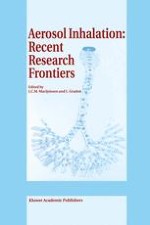1996 | Buch
Aerosol Inhalation: Recent Research Frontiers
Proceedings of the International Workshop on Aerosol Inhalation, Lung Transport, Deposition and the Relation to the Environment: Recent Research Frontiers, Warsaw, Poland, September 14–16, 1995
herausgegeben von: J. C. M. Marijnissen, L. Gradoń
Verlag: Springer Netherlands
Enthalten in: Professional Book Archive
